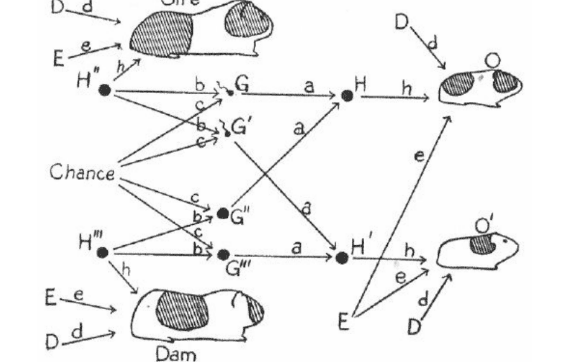Have you ever seen a guinea pig?
The little guinea pig once also helped promote the development of cause and effect. The protagonist of today’s sharing, Sewell Wright, once raised guinea pigs in the United States Department of Agriculture. In his spare time, he studied the relationship between coat color and genetics, environment, and other factors, and unearthed new discoveries in the science of cause and effect.

Sewell Wright gets a PhD from Harvard University After his degree, he worked for the U.S. Department of Agriculture raising guinea pigs.
This not only became the springboard for Wright's entire career, but also became a turning point in the evolution of the science of causality.
At this time, the famous biologist Greg Mendel's theory of dominant and recessive genes had just been rediscovered. But in his work research, Wright discovered that the inheritance of coat color in guinea pigs conflicts with Mendel's laws of inheritance.
Mendel’s laws of inheritance predict that multiple generations of inbreeding can “fix” certain traits. But it turns out that it is impossible to breed pure white or pure-colored guinea pigs. Even the offspring of multiple generations of inbred guinea pig families have obvious variations in coat color, ranging from mostly white to mostly colored.
Based on this discovery, Wright began to suspect that the amount of hair white pigment is independently controlled by a certain gene, and based on this, he proposed a hypothesis: it is some kind of "development factor" that exists in the uterus of the mother mouse. (developmental factors) lead to variations in certain characteristics of guinea pigs.

In order to study the relationship between various factors, Wright painted A relationship diagram is drawn, or called a "path diagram":
In this relationship diagram, the unknown target quantity is D, which is the influence of "development factors" on white hair, and H represents genetics. Factor, E represents the environmental factor, and Chance represents the random factor.
Wright said that if you want to explore the causal quantity of the relationship diagram, you can infer the correlation in the data through a simple graphic rule. If you break down the arrows in the diagram one by one, you will find that each arrow has a very clear meaning.
Wright's original analytical method builds a bridge between the profound and hidden world of causality and the superficial world of correlation. After building this bridge, he can perform the reverse practice and discover the causal quantities D and H (second level) hidden behind the correlation measured based on the data (first level).
The author believes that the road map is a very revolutionary idea, because it proves for the first time that the judgment that "correlation does not equal causation" should give way to "some correlations do mean causation" relation".
In the end, through analysis and calculations, Wright concluded that in randomly bred guinea pigs, hypothetical developmental factors played a more important role than genetic factors.
The road map pioneered by Wright has since been greatly developed, with applications far beyond the initial study of guinea pig genes.
A path diagram is not just a pretty picture, but a powerful computational tool that builds the first bridge between causality and probability theory, spanning the second level of the ladder of causality. and the first level of barriers.
It combines two completely different and almost incompatible mathematical languages - graphic language (qualitative "arrow pointing information") and data language (quantitative "data information") to combine cause and effect. The study of relationship science has led to a whole new field of research.
In 1953, Herbert Simon (winner of the 1978 Nobel Prize in Economics) rediscovered this method of using path diagrams, which brought great influence to many research works in the social sciences. Inspire.
Although this method was disparaged by Pearson's successor Niels, the author believes that Wright's paper should be regarded as a milestone in the development of biology in the 20th century and in the history of the development of the science of causality. milestone.
Facing doubts from the outside world, he refuted the opinions through a path diagram and perfected the theory of path method. The next chapter will continue to be shared, so stay tuned.

 扫一扫微信交流
扫一扫微信交流
发布评论